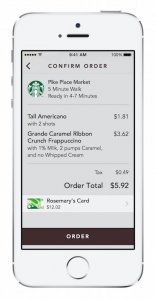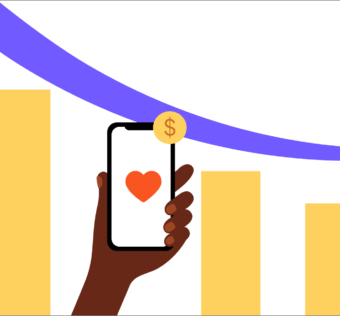Engage Your Church Members the Starbucks Way
Starbucks coffee shops are ubiquitous. With more than 12,000 locations in the U.S. it’s not far behind McDonald’s. The company has created an immediately identifiable brand and culture. The design of their stores consistently represents what they are about while fully integrating themselves into the communities where their stores are located
The tables and seating at fast food joints are designed to be uncomfortable. The goal of the entire experience is to increase turnover—get in, get your food, get out. The tables and furniture at Starbucks are comfortable and encourage sitting, staying, and socializing. Their stores have become a de facto casual gathering place and business meeting space. Add in their slick mobile app, their partnership with Apple for the iTunes Song of the Week and App of the Week, and they’ve integrated themselves into people’s everyday lives.
Throughout history, churches have served much the same purpose. They were a hub of their communities, a place where people flocked to worship, engage with each other, and conduct business. They have on the whole, however, been slow to adapt to new technology as a means of remaining relevant. People have sought out and found alternatives like coffee shops, supplanting the central role the church plays in their lives.
Bringing Churches Back With Technology
How can churches regain their position and play a critical role in a community’s development? Some feel the answer lies in adopting new technology as well as new ways of thinking.
Andrew Lloyd Webber, writer of “Cats” and other smash-hit Broadway musicals, thinks the answer lies with technology–especially WiFi. Embracing the use of mobile devices and the internet would enable places of worship to once again be a center of attraction. He suggests that every church provide free access to WiFi and facilities to the broader community.
“Once you do that, the church becomes the centre of the community again,” Webber said in an interview with the Daily Mail. “They should go back to the medieval tradition, which is that the nave of the church is always used for local business.”
Reverend Dr. William Curtis, Senior Pastor of Mt. Ararat Baptist Church, Pittsburgh, PA, agrees that the church’s role in the community is bigger than just a place for worship services. His church is overseeing expansion of their Mount Ararat Community Activity Center, a $20 million construction project that will serve the area with a wide range of services.
“Whether it’s going to a Zumba class, after-school study for kids, a quality child care center, or taking computer skills classes in the technology center, there’s always something going on,” said Curtis. “We have a responsibility to be the center of social activity. If you’re bored, come to church. If you want to take a class, come to church.”
Mobile Apps? Not In My Church!
Why would places of worship want to encourage their members to use smartphones and tablets before, during and after services? While many pastors and church administrators fear a distraction from worship, this fear illustrates a disconnect with the wants, needs and expectations of their members.
People are attached to their smartphones and mobile apps as they are to no other device:
One in five (20%) Americans report using their phones in church or other place of worship.
Nearly three-quarters (72%) of Americans are always within five feet of their smart device.
Over one-third (35%) use their phones in movie theaters. (Jumio survey).
The popular Bible app YouVersion has been downloaded and installed on almost 170 million devices, and is available in 1,092 versions in 780 languages.
Those numbers equate to a level of ubiquity on par with the Starbucks mobile app. In 2013, of the $1.6 billion Americans spent via their smartphones, 90 percent went to Starbucks. Customers pay for a purchase using the app seven million times per week, with mobile payments accounting for 16% of all in-store transactions.
Of the 47 million weekly transactions across their 12,000 stores, seven million are customers paying with the smartphones, according to Starbucks CEO Howard Schultz.
“We continue to see broad customer acceptance and adoption of our mobile payment technologies,” Schultz said in a fourth quarter earnings call. “Today in the U.S. alone, over 13 million customers were actively using our mobile apps. And we are now averaging more than 7 million mobile transactions in our stores each week—representing 16% of total tender. That’s more than any other bricks-and-mortar retailer in the marketplace.”
Mobile Apps, Strategy, and New Members
The Starbucks numbers are staggering, and point to a wide and growing adoption of integrating mobile apps and payments into the culture and lifestyle of their customers. Key to the success of their mission is the Starbucks mobile app and the strategy behind it. Their mobile app is integrated with the My Starbucks Rewards program, which added nearly 900,000 new members in December, 2014, and boasts a total membership of over nine million people.
The mobile app’s ease of use and integrated loyalty program are clearly gaining and retaining more customers. It’s about more than simple transactions, though. The app provides coupons, a free song and app download from iTunes each week, and even the ability to give someone else a Starbucks gift. In other words, it keeps customers connected to an entire Starbucks-centered ecosystem. Schultz said the program is one of the company’s most important business drivers.
“New members contribute not only short-term increases in revenue and profit, but also long-term loyalty for years to come,” said Schultz in the Washington Post.
What Does Coffee Have To Do With My Church?
What is local business? It’s not trading goats and wheat: it’s uplifting and educating the community. It’s providing people with vital services like child care, art, music, and physical activity. It’s also the business people conduct on their smartphones in the course of their normal work.
Walk into any Starbucks and you see many–if not most–customers using laptops, smartphones and tablets. They use the free WiFi, get work done, read books on their tablets or shop online. Clearly the majority of these people are also using the Starbucks mobile app to pay for their orders.
Churches stand to learn valuable lessons from Starbucks. By encouraging the adoption and use of technology, churches reposition themselves as vital community resources. Additionally there are bible apps, church apps that allow members to view sermons and lessons, and mobile giving apps that enable members to make offerings and tithes. Ignoring or outright forbidding the use of such technology hampers the church mission of providing vital services and information that people today expect as a matter of course.




